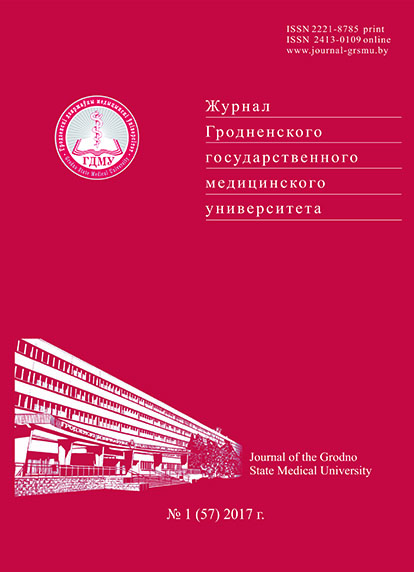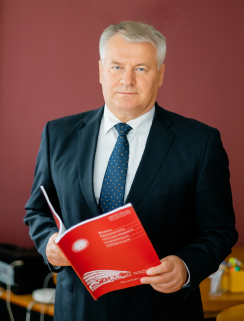ОСЛОЖНЕНИЯ ПРОЦЕДУРЫ РАДИОЧАСТОТНОЙ АБЛЯЦИИ УСТЬЕВ ЛЕГОЧНЫХ ВЕН ПРИ ФИБРИЛЛЯЦИИ ПРЕДСЕРДИЙ
Аннотация
Фибрилляция предсердий – аритмия, сопровождающаяся значительными социально-экономическими потерями в связи с большой распространенностью, повышенным риском развития инсультов и тромбоэмболий, инвалидизации и смерти. Для лечения данной аритмии в клинической практике в последние два десятилетия успешно применяется метод радиочастотной абляции устьев легочных вен. Вместе с тем врачам и пациентам необходимо учитывать возможные осложнения этой процедуры, а также меры профилактики их развития и их лечение.
Литература
Consensus Statement on catheter and surgical ablation of atrial fibrillation : recommendations for personnel, policy, procedures and follow-up : a report Heart Rhythm Society (HRS) Task Force on catheter and surgical ablation of atrial fibrillation / H. Calkins [et al.] // Heart Rhythm. – 2007. – Vol. 4, iss. 6. – P. 816-861.
Spontaneous initiation of atrial fibrillation by ectopic beats originating in the pulmonary veins / M. Haissaguerre [et al.] // N. Engl. J. Med. – 1998. – Vol. 339 (10). – P. 659-666.
Updated worldwide survey on the methods, efficacy, and safety of catheter ablation for human atrial fibrillation / R. Cappato [et al.] // Circ. : Arrhythm Electrophysiol. – 2010. – Vol. 3, iss. 1. – P. 32-38.
Complications of catheter ablation for atrial fibrillation: incidence and predictors / D. D. Spragg [et al.] // J. Cardiovasc. Electrophysiol. – 2008. – Vol. 19. – P. 627-631.
Prevalence and predictors of complications of radiofrequency catheter ablation for atrial fibrillation / T. S. Baman [et al.] // J. Cardiovasc. Electrophysiol. – 2011. – Vol. 22, iss. 6. – P. 626-631.
Low risk of major complications associated with pulmonary vein antral isolation for atrial fibrillation : results of 500 consecutive ablation procedures in patients with low prevalence of structural heart disease from a single center / G. Lee [et al.] // J. Cardiovasc. Electrophysiol. – 2011. – Vol. 22, iss. 2. – P. 163-168.
Radiofrequency ablation of accessory pathways : a 14-year experience at the Tel Aviv Medical Center in 508 patients / B. Belhassen [et al.] // Isr. Med. Assoc. J. – 2007. – Vol. 9. – P. 265-270.
Early complications of pulmonary vein catheter ablation for atrial fibrillation : a multicenter prospective registry on procedural safety / E. Bertaglia [et al.] // Heart Rhythm. – 2007. – Vol. 4, iss. 10. – P. 1265-1271.
Complications of atrial fibrillation ablation in a high-volume center in 1,000 procedures: still cause for concern? / N. Dagreset [et al.] // J. Cardiovasc. Electrophysiol. – 2009. – Vol. 20, iss. 9. – P. 1014-1019.
Hindricks, G. The Multicentre European Radiofrequency Survey (MERFS): complications of radiofrequency catheter ablation of arrhythmias. The Multicentre European Radiofrequency Survey (MERFS) investigators of the Working Group on Arrhythmias of the European Society of Cardiology / G. Hindricks // Eur. Heart J. – 1993. – Vol. 14, iss. 12. – 1644-1653.
Catheter ablation of accessory pathways, atrioventricular nodal reentrant tachycardia, and the atrioventricular junction : final results of a prospective, multicenter clinical trial. The Atakr Multicenter Investigators Group / H. Calkins [et al.] // Circulation. – 1999. – Vol. 99, iss. 2. – P. 262-270.
Prevalence and causes of fatal outcome in catheter ablation of atrial fibrillation / R. Cappato [et al.] // J. Am. Coll. Cardiol. – 2009. – Vol. 53. – P. 1798-1803.
Assessment of the catheter tip contact force resulting in cardiac perforation in the swine atria using the force sensing technology / F. Perna [et al.] // Circ. : Arrhythm. Electrophysiol. – 2011. – Vol. 4, iss. 2. – P. 218-224.
Catheter tip force required for mechanical perforation of porcine cardiac chambers / D. Shah [et al.] // Europace. – 2011. – Vol. 13, iss. 2. – P. 277-283.
Prevalence and causes of fatal outcome in catheter ablation of atrial fibrillation / R. Cappato [et al.] // J. Am. Coll. Cardiol. – 2009. – Vol. 53. – P. 1798-1803.
Verma, A. Should atrial fibrillation ablation be considered first-line therapy for some patients? Why atrial fibrillation ablation should be considered first-line therapy for some patients / A. Verma, A. Natale // Circulation. – 2005. – Vol. 112. – P. 1214-1222.
Atrio-esophageal fistula as a complication of percutaneous transcatheter ablation of atrial fibrillation / C. Pappone [et al.] // Circulation. – 2004. – Vol. 109, iss. 22. – P. 2724-2726.
Left atrial-esophageal fistula following radiofrequency catheter ablation of atrial fibrillation / M. I. Scanavacca [et al.] // J. Cardiovasc. Electrophysiol. – 2004. – Vol. 15, iss. 8. – P. 960-962.
Esophageal perforation during left atrial radiofrequency ablation : is the risk too high? / N. Doll [et al.] // J. Thorac. Cardiovasc. Surg. – 2003. – Vol. 125 (4). – P. 836-842.
Computed tomographic analysis of the anatomy of the left atrium and the esophagus : implications for left atrial catheter ablation / K. Lemola [et al.] // Circulation. – 2004. – Vol. 110. – P. 3655-3660.
Initial experience of assessing esophageal tissue injury and recovery using delayed-enhancement MRI after atrial fibrillation ablation / T. J. Badger [et al.] // Circ. : Arrhythm. Electrophysiol. – 2009. – Vol. 2. – P. 620-625.
Temporary esophageal stenting allows healing of esophageal perforations following atrial fibrillation ablation procedures / T. J. Bunch [et al.] // J. Cardiovasc. Electrophysiol. – 2006. – Vol. 17. – P. 435-439.
Incidence and predictors of major complications from contemporary catheter ablation to treat cardiac arrhythmias / M. Bohnen [et al.] // Heart Rhythm. – 2011. – Vol. 8. – P. 1661-1666.
Incidence and prevention of cardiac tamponade complicating ablation for atrial fibrillation / L. F. Hsu [et al.] // Pacing Clin. Electrophysiol. – 2005. – Vol. 28, suppl. 1. – P. 106-109.
Verma, A. Should atrial fibrillation ablation be considered first-line therapy for some patients? Why atrial fibrillation ablation should be considered first-line therapy for some patients / A. Verma, A. Natale // Circulation. – 2005. – Vol. 112. – P. 1214-1222.
Ross, J. Jr. Transseptal left atrial puncture ; new technique for the measurement of left atrial pressure in man / J. Jr. Ross, E. Braunwald, A. G. Morrow // Am. J. Cardiol. – 1959. – Vol. 3. – P. 653-655.
Troubleshooting difficult transseptal catheterization / R. W. Sy [et al.] // J. Cardiovasc. Electrophysiol. – 2011. – Vol. 22. – P. 723-727.
Transseptal puncture using minimally invasive echocardiography during atrial fibrillation ablation / L. Mitchell-Heggs [et al.] // Europace. – 2010. – Vol. 12. – P. 1435-1438.
Trans-septal catheterization in the electrophysiology laboratory : data from a multicenter survey spanning 12 years / R. De Ponti [et al.] // J. Am. Coll. Cardiol. – 2006. – Vol. 47. – P. 1037-1042.
Efficacy and safety of septal and left-atrial linear ablation for atrial fibrillation / P. Jaïs [et al.] // Am. J. Cardiol. – 1999. – Vol. 84. – P. 139-146.
Atrial fibrillation ablation in patients with therapeutic international normalized ratio : comparison of strategies of anticoagulation management in the periprocedural period / O. M. Wazni [et al.] // Circulation. – 2007. – Vol. 116. – P. 2531-2534.
Periprocedural stroke and management of major bleeding complications in patients undergoing catheter ablation of atrial fibrillation: the impact of periprocedural therapeutic international normalized ratio / L. Di Biase [et al.] // Circulation. – 2010. – Vol. 121. – P. 2550-2556.
Risk of thromboembolic events after percutaneous left atrial radiofrequency ablation of atrial fibrillation / H. Oral [et al.] // Circulation. – 2006. – Vol. 114. – P. 759-765.
The risk of thromboembolism and need for oral anticoagulation after successful atrial fibrillation ablation / S. Themistoclakis [et al.] // J. Am. Coll. Cardiol. – 2010. – Vol. 55. – P. 735-743.
Radiofrequency catheter ablation of atrial fibrillation : a cause of silent thromboembolism? Magnetic resonance imaging assessment of cerebral thromboembolism in patients undergoing ablation of atrial fibrillation / F. Gaita [et al.] // Circulation. – 2010. – Vol. 122. – P. 1667-1673.
Pulmonary vein stenosis complicating catheter ablation of focal atrial fibrillation / M. I. Scanavacca [et al.] / J. Cardiovasc. Electrophysiol. – 2000. – Vol. 11. – P. 677-681.
Takahashi, A. Complications in the catheter ablation of atrial fibrillation : incidence and management / A. Takahashi, T. Kuwahara, Y. Takahashi // Circ. J. – 2009. – Vol. 73. – P. 221-226.
Impact of integration of multislice computed tomography imaging into three-dimensional electroanatomic mapping on clinical outcomes, safety, and efficacy using radiofrequency ablation for atrial fibrillation / M. Martinek [et al.] // Pacing Clin. Electrophysiol. – 2007. – Vol. 30. – P. 1215-1223.
Incidence, management, and outcome in significant pulmonary vein stenosis complicating ablation for atrial fibrillation / H. Purerfellner [et al.] // Am. J. Cardiol. – 2004. – Vol. 93. – P. 1428-1431.
Incidence and predictors of periprocedural cerebrovascular accident in patients undergoing catheter ablation of atrial fibrillation / D. Scherr [et al.] // J. Cardiovasc. Electrophysiol. – 2009. – Vol. 20. – P. 1357-1363.
Holmes, D. R. Jr. Pulmonary vein stenosis complicating ablation for atrial fibrillation: clinical spectrum and interventional considerations / D. R. Jr. Holmes, K. H. Monahan, D. Packer // JACC Cardiovasc. Interv. – 2009. – Vol. 2. – P. 267-76.
Teplitsky, L. Catheter based cryoablation and radiofrequency ablation for atrial fibrillation results in conductive heat transfer from and to the esophagus / L. Teplitsky, D. D. Hegland, T. D. Bahnson // Heart Rhythm. – 2006. – Vol. 3. – P. 242.
Circumferential pulmonary vein isolation with the cryoballoon technique results from a prospective 3-center study / T. Neumann [et al.] // J. Am. Coll. Cardiol. – 2008. – Vol. 52 (4). – P. 273-278.
Phrenic nerve injury after atrial fibrillation catheter ablation : characterization and outcome in a multicenter study / F. Sacher [et al.] // J. Am. Coll. Cardiol. – 2006. – Vol. 47. – P. 2498-2503.
Phrenic nerve injury after catheter ablation : should we worry about this complication? / R. Bai [et al.] // J. Cardiovasc. Electrophysiol. – 2006. – Vol. 17. (9). – P. 944-948.
Stroke risk associated with balloon based catheter ablation for atrial fibrillation : rationale and design of the MACPAF Study / K. G. Haeusler [et al.] // BMC Neurol. – 2010. – Vol. 10. – P. 63.
First report of phrenic nerve injury during pulmonary vein isolation using the Ablation Frontiers pulmonary vein ablation catheter / S. Y. Ahsan [et al.] // J. Interv. Card. Electrophysiol. – 2010. – Vol. 29 (3). – P. 187-190.
Mechanisms of phrenic nerve injury during radiofrequency ablation at the pulmonary vein orifice / T. J. Bunch [et al.] // J. Cardiovasc. Electrophysiol. – 2005. – Vol. 16 (12). – P. 1318-1325.
Acute pyloric spasm and gastric hypomotility : an extracardiac adverse effect of percutaneous radiofrequency ablation for atrial fibrillation / D. Shah [et al.] // J. Am. Coll. Cardiol. – 2005. – Vol. 46 (2). – P. 327-330.
Esophageal temperature monitoring during radiofrequency ablation of atrial fibrillation / D. P. Redfearn [et al.] // J. Cardiovasc. Electrophysiol. – 2005. – Vol. 16 (6). – P. 589-593.
Left atrial tachycardia after circumferential pulmonary vein ablation for atrial fibrillation : incidence, electrophysiological characteristics, and results of radiofrequency ablation / I. Deisenhofer [et al.] // Europace. – 2006. – Vol. 8 (8). – P. 573-582.
Prevention of iatrogenic atrial tachycardia after ablation of atrial fibrillation : a prospective randomized study comparing circumferential pulmonary vein ablation with a modified approach / C. Pappone [et al.] // Circulation. – 2004. – Vol. 110. – P. 3036-3042.
Freedom from atrial tachyarrhythmias after catheter ablation of atrial fibrillation : a randomized comparison between 2 current ablation strategies / M. R. Karch [et al.] // Circulation. – 2005. – Vol. 111 (22). – P. 2875-2880.
Gerstenfeld, E. P. Mapping and ablation of left atrial tachycardias occurring after atrial fibrillation ablation / E. P. Gerstenfeld, F. E. Marchlinski // Heart Rhythm. – 2007. – Vol. 4. – P. 65-72.
Guidelines for the Management of Patients with Atrial Fibrillation : a report of the ACC / AHA Task Force on Practice Guidelines and the ESC Committee for Practice Guidelines (Writing Committee to Revise the 2001 Guidelines for the Management of Patients With Atrial Fibrillation) : developed in collaboration with the European Heart Rhythm Association and the Heart Rhythm Society ; V. Fuster [et al.] // Circulation. – 2006. – Vol. 114. – P. e257-e354.





























